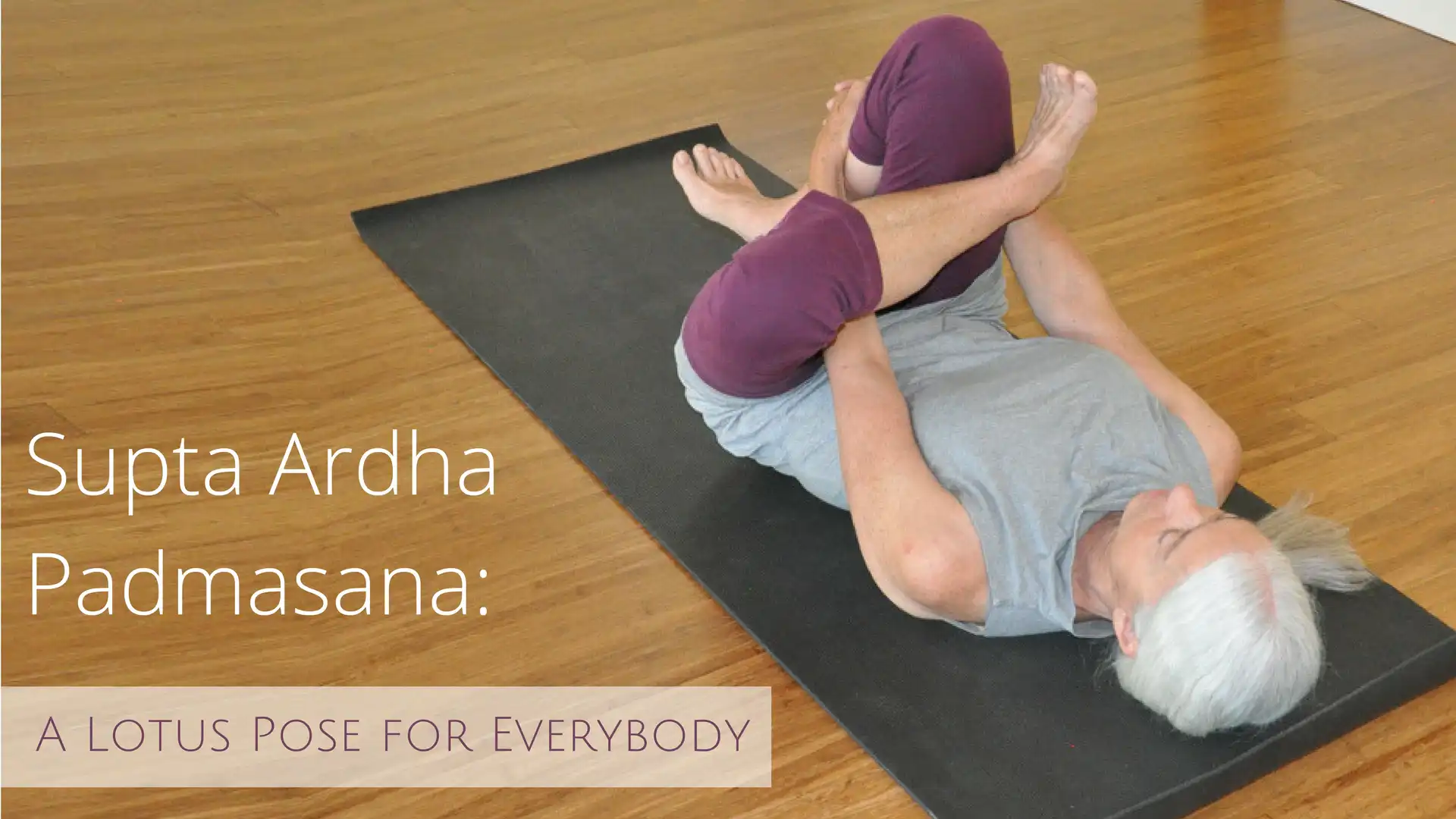Supine Half Lotus Pose (Supta Ardha Padmasana): A Lotus Pose for Everybody

In 2001, I co-taught a teacher training with Donna Farhi in Vancouver, BC. The 50 attendees were experienced yoga teachers and bodyworkers from all over the world. During the training, we questioned teaching methodologies that shoehorn students into a one-size-fits-all model.
One misconception we talked about was the perceived necessity of practicing what is probably yoga’s most emblematic pose: Padmasana (Lotus Pose). That day we spent two hours practicing the poses Donna recommends to prep the body to practice Lotus Pose. When we tried Padmasana toward the end of the class, I noticed that despite the depth and experience of attendees, only three out of 50 people could actually do it.
This was very surprising to me. I’d always been under the impression that anyone who tried hard enough and practiced right could eventually do Lotus. This may be true for some people—Donna told us it took her 10 years of careful, patient practice to ease her hip joints into Padmasana.
But it’s not true that anyone can form their legs into Lotus position, no matter how committed their practice. Thanks to a workshop I took with Paul Grilley on Anatomy for Yoga, I discovered that tightness in soft tissue is not the most common reason people can’t do Padmasana. According to Grilley, it’s all in the bones.
Tips on Supta Ardha Padmasana: The Skeleton and Yoga Asana Practice

Some bodies will never be able to do full Lotus, not because the owners of these bodies are inferior yogis or that they’re not trying hard enough, but because their hip joints are formed in such a way that they do not allow the amount of external rotation required to sit in Lotus. There are many factors—all within the realm of normal—that influence the amount of external rotation in your joints. The depth, placement, and orientation of your hip sockets can influence whether your thighs tend to rotate inward or outward more easily.
The shape and rotation of the heads and necks of the femurs also affect the rotation, as does the shape and rotation of the shaft of the femur bones.
Fortunately, there’s no pose in yoga—including Lotus—you need to do to be a “good” yogi. Yoga has never been about what your body can or can’t do.
Even so, I have found that most people are capable of and can benefit from practicing Supta Ardha Padmasana (Supine Half Lotus Pose). Among other benefits, the Supine Half Lotus stretches the piriformis muscles and external rotators that cross the sacroiliac (SI) joint. When the piriformis is tense, it can press on the sciatic nerve, possibly causing sciatica, and can also contribute to sacroiliac dysfunction. Practicing Supta Ardha Padmasana can sometimes alleviate sciatic pain and can sometimes relieve excessive torque on your SI joint.
Half Lotus is traditionally practiced in a seated position. However, I like to practice it lying down for several reasons. First, lying on your back removes the restriction of the floor under your legs. It allows your top leg to cross your bottom leg more easily. Second, lying on your back gives you feedback as to whether your back is in a healthy position. Many people round their spines when they try to form Half Lotus from a sitting position. It is much easier to maintain a neutral spine when you are lying down.
Here are some more tips on Supta Ardha Padmasana:
Tips on Supta Ardha Padmasana: the pose in Eight Steps
- Begin by lying on the floor on a yoga mat or blanket. Bend both knees and place the soles of your feet on the floor.
- Cross your right ankle all the way across your left thigh so that your ankle, not your foot, is resting on the thigh. Many people prefer to place their right ankle a few inches from the knee, while others (like me) prefer to place the ankle closer to the left hip joint. Try it both ways or at points in between to see what feels best for you.
- Thread your right arm through the opening behind your right knee and grab the back of your left leg. Wrap your left hand around the back of your left leg and interlace the fingers of both hands. If your hands don’t connect with each other, you can connect them with a belt or a yoga strap.
- This is important: Flex your right ankle and keep it flexed the entire time. This keeps both your knee and ankle stable.
- Draw both legs toward your torso, relaxing your shoulders and arms.
- Take deep abdominal breaths, creating space on the inhalations and settling into that space on your exhalations.
- Take five to ten deep breaths before releasing your legs and letting both feet rest on the floor.
- Take a few breaths, simply lying on your back to feel what changed. How are the two sides of the pelvis resting on the floor? Does one side of your body feel longer than the other? When you feel ready, move to your second side.
If at any point you feel even the tiniest discomfort in either knee, please let go of the pose. There is no such thing as a “good” knee pain. Lotus can be hard on knees—less so when you are lying down and practicing only one leg at a time—but please do be cautious.
Tips on Supta Ardha Padmasana: Avoid This Common Misalignment
Many people practice Padmasana with their feet, rather than their ankles, atop opposite thighs, so that their outer ankles are intensely stretching and the soles of their feet are facing upward. This is not Lotus Pose. This is a recipe for overstretched ligaments in your ankles and possible knee destabilization. One person I know sat this way for an hour and ended up having bilateral knee surgeries as a result.
That is why so many experienced practitioners were unable to do Lotus in Donna’s teacher training. We made sure that people were practicing healthy alignment principles when they finally placed their legs in the Lotus position. Practicing Padmasana with healthy alignment, with your ankles flexed and sitting on top of your thighs, is only possible for people whose hip joints externally rotate more than normal. Many people can do the misaligned version of Lotus, but not that many people have the extreme range of motion required to do it with the ankles—not the feet—on top of their thighs.
While Instagram photos of people doing Lotus Pose in bikinis on sunset-lit beaches may conjure romantic ideas about its importance in the canon of yoga poses, please remember that it’s not for everyone. Whether or not your body can do Padmasana—or any other pose—is not a measure of your character or worth as a yoga practitioner.
Supta Ardha Padmasana, though, can be a healthy staple in your repertoire of asanas. It confers many of the benefits of Padmasana but few of its potential risks. What matters is not whether you were born with a skeleton that can move in a particular way. What matters is the care, respect, and mindfulness you bring to whatever pose you practice in a given moment.
Here’s another yoga pose primer from YogaUOnline and special contributor Charlotte Bell: Garudhasana: How to Spread Your Wings.
Reprinted with permission from Hugger Mugger Yoga Products blog.
 Charlotte Bell began practicing yoga in 1982 and began teaching in 1986. She was certified by B.K.S. Iyengar in 1989 following a trip to Pune. 1986 she began practicing Insight Meditation with her mentors Pujari and Abhilasha Keays. Her asana classes blend mindfulness with physical movement. Charlotte writes a column for Catalyst Magazine and serves as editor for Yoga U Online. She is the author of two books: Mindful Yoga, Mindful Life and Yoga for Meditators, both published by Rodmell Press. She also edits the Hugger Mugger Yoga Products¹ blog and is a founding board member for GreenTREE Yoga, a non-profit that brings yoga to underserved populations. A lifelong musician, she plays oboe and English horn in the Salt Lake Symphony and the folk sextet Red Rock Rondo, whose 2010 PBS music special won two Emmys.
Charlotte Bell began practicing yoga in 1982 and began teaching in 1986. She was certified by B.K.S. Iyengar in 1989 following a trip to Pune. 1986 she began practicing Insight Meditation with her mentors Pujari and Abhilasha Keays. Her asana classes blend mindfulness with physical movement. Charlotte writes a column for Catalyst Magazine and serves as editor for Yoga U Online. She is the author of two books: Mindful Yoga, Mindful Life and Yoga for Meditators, both published by Rodmell Press. She also edits the Hugger Mugger Yoga Products¹ blog and is a founding board member for GreenTREE Yoga, a non-profit that brings yoga to underserved populations. A lifelong musician, she plays oboe and English horn in the Salt Lake Symphony and the folk sextet Red Rock Rondo, whose 2010 PBS music special won two Emmys.



